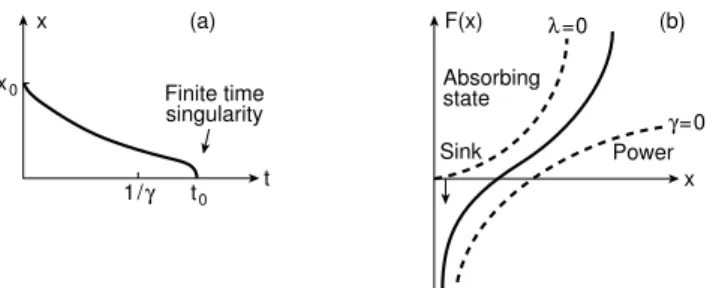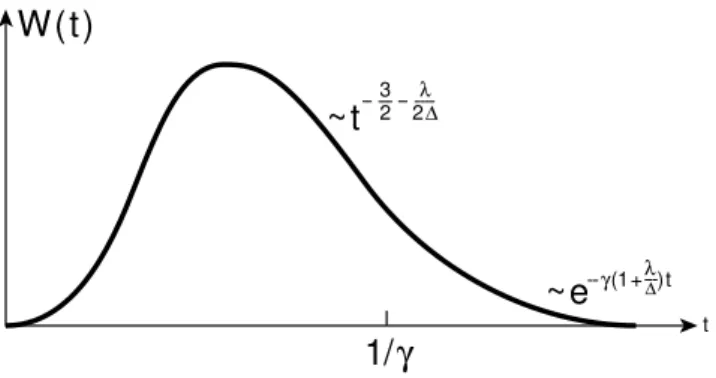634 Brazilian Journal of Physics, vol. 33, no. 3, September, 2003
Finite-Time-Singularity with Noise and Damping
Hans C. Fogedby
Institute of Physics and Astronomy, University of Aarhus, DK-8000, Aarhus C, Denmark and
NORDITA, Blegdamsvej 17, DK-2100, Copenhagen Ø, Denmark
Received on 14 May, 2003
The combined influence of linear damping and noise on a dynamical finite-time-singularity model is considered for a single degree of freedom. The noise resolves the finite-time-singularity and replaces it by a first-passage-time distribution with a peak at the singularity and a long first-passage-time tail. The damping introduces a characteristic cross-over time. In the early time regime the first-passage-time distribution shows a power law behavior with scaling exponent depending on the ratio of the non linear coupling strength to the noise strength. In the late time regime the damping prevails. The study might be of relevance in the context of hydrodynamics on a nanometer scale, in material physics, and in biophysics.
I
Introduction
The influence of noise on the behavior of nonlinear dynami-cal system is a recurrent theme in modern statistidynami-cal physics [1]. In a particular class of systems the nonlinear character gives rise to finite-time-singularities, that is solutions which cease to be valid beyond a particular finite time span. One encounters finite-time-singularities in stellar structure, tur-bulent flow, and bacterial growth [2, 3, 4]. The phenomenon is also seen in Euler flows and in free-surface-flows [5, 6].
In the context of hydrodynamical flow on a nanoscale [8], where microscopic degrees of freedom come into play, it is a relevant issue how noise influences the hydrodynami-cal behavior near a finite-time-singularity. Leaving aside the issue of the detailed reduction of the hydrodynamical equa-tions to a nanoscale and the influence of noise on this scale to further study, we assume in the present context that a sin-gle variable or “reaction coordinate” effectively captures the interplay between the singularity and the noise.
II
Model without damping
In a recent paper [13] we investigated a simple generic model system with one degree of freedom governed by a nonlinear Langevin equation driven by Gaussian white noise,
dx dt =−
λ
2|x|+η , hηηi(t) = ∆δ(t). (1) The model is characterized by the coupling parameterλ, de-termining the amplitude of the singular term and the noise parameter∆, determining the strength of the noise correla-tions. Specifically, in the case of a thermal environment at temperatureT the noise strength∆∝T.
In the absence of noise this model exhibits a finite-time-singularity at a time t0, where the variable x
van-ishes with a square law dependence. When noise is added the finite-time-singularity event at t0 becomes a statistical
event and is conveniently characterized by a first-passage-time distribution W(t)[9]. For vanishing noise we have
W(t) =δ(t−t0), restating the presence of the
finite-time-singularity. In the presence of noiseW(t)develops a peak aboutt = t0, vanishes at short times, and acquires a long
time tail.
The model in Eq. (1) has also been studied in the con-text of persistence distributions related to the nonequilib-rium critical dynamics of the two-dimensional XY model [10] and in the context of non-Gaussian Markov processes [11]. Finally, regularized for smallx, the model enters in connection with an analysis of long-range correlated station-ary processes [12].
From our analysis in ref. [13] it followed that the distri-bution at long times is given by the power law behavior
W(t)∼t−α
, α= 3
2+
λ
2∆. (2)
For vanishing nonlinearity, i.e., λ = 0, the finite-time-singularity is absent and the Langevin equation (1) describes a simple random walk of the reaction coordinate, yielding the well-known exponent α = 3/2 [14]. In the nonlin-ear case with a finite-time-singularity the exponent attains a universal correction, depending on the ratio of the non-linear strength to the strength of the noise; for a thermal environment the correction is proportional to1/T.
III
Model with damping
Hans C. Fogedby 635
the fluctuation-dissipation theorem relating the damping to the noise. In the present paper we attempt to amend this sit-uation and thus summarize the results of an extension of the analysis in ref. [13] to the case of linear damping.
For this purpose we consider the following model for one degree of freedom:
dx
dt =−γx− λ
2|x| +η , hηηi= ∆δ(t). (3) In addition to the coupling parameterλ, and the noise pa-rameter∆, this model is also characterized by the damping constantγ. Assuming for convenience a dimensionless vari-ablexthe coupling, noise strength, and damping,λ,∆, and
γhave the dimension1/time. The ratiosλ/∆andγ/∆are thus dimensionless parameters characterizing the behavior of the system. In terms of a free energy or potentialF we can express Eq. (3) in the form
dx dt =−
1 2
dF
dx +η(t), (4)
whereFis given by
F=γx2+λln|x|.
(5) The free energy has a logarithmic sink and drivesxto the absorbing statex= 0. For largexthe free energy has the form of a harmonic well potential confining the motion. In Fig. 1 we have depicted the noiseless solution forη= 0and the free energy in the various cases.
In order to model an experimental situation the first-passage-time distribution W(t)is of direct interest. First-passage properties in fact underlie a large class of stochastic processes such as diffusion limited growth, neuron dynam-ics, self-organized criticality, and stochastic resonance [9].
(b) (a)
x F(x)
x
Absorbing state Finite time
singularity
λ=0
Sink Power
t0 x0
t 1/γ
γ=0
Figure 1. In a) we show the time evolution of the single degree of freedomx. At times shorter than the cross-over time1/γthe vari-ablexfalls off exponentially. At times beyond1/γ the variable
xreaches the absorbing statex = 0at a finite timet0. In b) we depict the free energyF(x)driving the equation. Forλ = 0the free energy forms a confining harmonic well, forγ = 0we have the absorbing state case discussed in ref. [13]. In the general case the absorbing statex= 0corresponds to the sink inF(x).
In term of the distribution function P(x, t) the ab-sorbing state distribution W(t) is defined as W(t) =
−R∞
0 ∂P(x, t)/∂tdx. In the absence of noise P(x, t) =
δ(x−x(t))andW(t) =δ(t−t0), in accordance with the
finite time singularity att =t0. For weak noise we
antic-ipate thatW(t)will peak aboutt0with vanishing tails for
smalltand larget.
In an analysis to be detailed elsewhere we have solved the Fokker-Planck equation associated with the Langevin equation (3),
∂P
∂t =
∆ 2
∂2P
∂x2 +
µ
γx+ λ
2x
¶
∂P
∂x +
µ
γ− λ
2x2
¶
P, (6)
analytically and have found for the probability distribution
P(x, t)
⌋
P(x, t) = x˜
λ/2∆+1/2 0
˜
xλ/2∆−1/2
γeγt/2
∆ sinhγtexp
·
−γ(˜x
2+ ˜x2 0)
2∆ sinhγt
¸
I1 2+
λ
2∆
µγ ∆
˜
xx˜0
sinhγt
¶
, (7)
and correspondingly for the first-passage-time distributionW(t)
W(t) = 2∆˜x
1+λ/∆ 0
Γ(1/2 +λ/2∆)exp ·
− γx˜
2 0
2∆ sinhγt
¸
exp(γt)
µ γ
2∆ sinhγt
¶32+
λ
2∆
. (8)
⌈
In Eq. (7)Iν is the Bessel function of imaginary argument,
Iν(z) = (−i)νJν(iz)[15] and we have introduced the time
scaled variables
x= ˜xexp(−γt/2), (9)
x0= ˜x0exp(+γt/2). (10)
From an analysis of Eq. (8) it follows that the damping constant sets an inverse time scale1/γ. At intermediate time scales forγt≪ 1the distribution exhibits the same power
law behavior as in the undamped case given by Eq. (2). At long times forγt≫1the distribution falls off exponentially with time constant1/γ(1 +λ/∆), i.e.,
W(t)∝exp[−γ(1 +λ/∆)t]. (11) In the short time limit W(t) vanishes exponentially and shows a maximum about the finite-time-singularity. In Fig. 2 we have depicted the first-passage-time-distribution as a function of t. In Fig. 3 we illustrate the behavior of
636 Brazilian Journal of Physics, vol. 33, no. 3, September, 2003
~t
-- ---3 2------λ
2∆
~e
--γ(1+∆λ)tt
1/
γ
W(t)
---Figure 2. We sketch the first-passage-time distributionW(t)as a function oft. In the limitt → 0W(t) vanishes exponentially; about the finite-time-singularityW(t)exhibits a maximum. At in-termediate times forγt≪1the distribution exhibits a power law behavior with scaling exponent3/2 +λ/2∆. In the long time limit forγt≫1an exponential fall-off with time constantγ(1 +λ/∆) characterizes the behavior ofW(t).
log W(t)
--log γ
log t
Damped
Power, slope = --
--
3
--2
---λ
2
∆
Figure 3. In this figure we sketch the behavior ofW(t)in a log-log plot. At intermediate times earlier that1/γ we have scaling behavior with exponent3/2 +λ/2∆, corresponding to a constant negative slope. In the long time limit the curve dips down indicat-ing the cross-over to exponential behavior.
IV
Conclusion
In this paper we have reviewed the problem of the com-bined influence of white Gaussian noise of strength∆ and a linear damping of strengthγ on a finite-time-singularity of strength λ. We have for simplicity considered only a single degree of freedom. We find that the first-passage-time distributionW(t)displays a peak about the finite-time-singularity and at intermediate times shorter than 1/γ a power law dependence∝t−α
, characterized by the scaling exponentα= 3/2 +λ/2∆. The exponent is nonuniversal and depends on the ratio between the singularity strengthλ
and the noise strength∆. In the case where the noise origi-nates from a thermal environment at temperatureT we have ∆ ∝T and the scaling exponent depends on the tempera-ture,α= 3/2 +const./T. At long times later than1/γthe behavior ofW(t)crosses over to a an exponential fall-off. To the extent that the character of a finite-time-singularity in the vicinity of threshold can be modelled by a single de-gree of freedom the present study should hold as regard the influence of noise on the time distribution. We note in partic-ular that in the case of a thermal environment at temperature
T the change of the scaling exponent becomes large in the limit of low temperatures as the distribution narrows around the noiseless threshold time. The present study also sug-gests generalizations to the case of several coupled variable subject to a finite-time-singularity.
References
[1] M. I. Freidlin and A. D. WentzelRandom Perturbations of Dynamical Systems(Springer, New York, 1998).
[2] R. M. Kerr and A. Brandenburg, Phys. Rev. Lett.83, 1155 (1999).
[3] M. P. Brenneret al., Phys. Fluids.9, 1573 (1997).
[4] M. P. Brenner, L. Levitov, and E. O. Budrene, Biophys. J.74, 1677 (1998).
[5] I. Cohen, M. Brenner, J. Eggers, and S. R. Nagel, Phys. Rev. Lett.83, 1147 (1999).
[6] J. Eggers, Rev. Mod. Phys69, 865 (1997).
[7] D. Sornette and J. V. Andersen, Int. J. Mod. Phys. C13, 171 (2002).
[8] J. Eggers, Phys. Rev. Lett.89,084502 (2002).
[9] S. Redner,A Guide to First-Passage Processes(Cambridge University Press, Cambridge, 2001).
[10] A. J. Bray, Phys. Rev. E62, 103 (2000).
[11] J. Farago, Europhys. Lett52, 379 (2000).
[12] F. Lillo, S. Miccich`e, and R. N. Mantegna, (2002), cond-mat/0203442.
[13] H. C. Fogedby and V. Poutkaradze, Phys. Rev. E66, 021103 (2002)
[14] H. Risken, The Fokker-Planck Equation (Springer-Verlag, Berlin, 1989).

